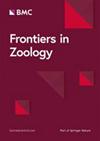Male reproductive system of the deep-sea acorn worm Quatuoralisia malakhovi (Hemichordata, Enteropneusta, Torquaratoridae) from the Bering Sea
IF 2.6
2区 生物学
Q1 ZOOLOGY
引用次数: 0
Abstract
The deep-sea acorn worm Quatuoralisia malakhovi belongs to the phylum Hemichordata, class Enteropneusta, family Torquaratoridae, which was described in 2005. Owing to their epibenthic lifestyle and deep-sea habitat features, torquaratorids differ anatomically from shallow-water acorn worms; however, their morphology and fine structure are poorly studied. We have the opportunity to make three complete detailed series of histological sections of Q. malakhovi and to study the microscopic anatomy, histology and fine structure of the reproductive system of this acorn worm using scanning and transmission electron microscopy. The sexes of Q. malakhovi are separate and indistinguishable externally. The lobed testes occupy the dorsal side of the genital wings and distinctly bulge into the peribranchial cavity by their mature lobes. The central part of the testis is always submerged into the genital wing and opens via a single gonad pore. The monociliary muscle cells stretch along the external wall of the testis and surround the gonad pore, probably taking part in the contraction of the testis lobes for spawning. The germinative epithelium of the testis contains spermatogenic cells at different stages of development and interstitial cells. Yolk cells are not found. Interstitial cells embrace the spermatogonia and spermatogenic columns, providing horizontal compartmentalization of the germinative epithelium, and contain numerous phagosomes with remnants of degenerating spermatogenic cells. The testis wall contains haemal lacunae, which are usually located on the side opposite the gonad pore. We describe the fine structure of spermatogonia, spermatocytes clustered in spermatogenic columns, spermatids, and spermatozoa. Spermatozoa are of the ectaquasperm type and consist of an acorn-shaped head and a flagellum 18–25 µm long. The sperm head includes a beak-shaped acrosomal part, a spherical nucleus and a midpiece containing a ring of 5 or rarely 6 mitochondria. The male reproductive system and sperm structure of Q. malakhovi, a representative of the family Torquaratoridae, have a number of differences from shallow-water acorn worms; however, the spermatogenesis and sperm structure of Q. malakhovi generally follow the pattern of the other three enteropneust families, and the phylogenetic significance of these deviations should be the subject of further research.白令海深海橡子虫 Quatuoralisia malakhovi(半知虫纲,Enteropneusta,Torquaratoridae)的雄性生殖系统
深海橡实虫(Quatuoralisia malakhovi)隶属于半知足目(Hemichordata),肠纲(Enteropneusta),Torquaratoridae科,于2005年被描述。由于它们的底栖生活方式和深海栖息地特征,Torquaratoridae 在解剖学上不同于浅水橡实虫;然而,对它们的形态和精细结构研究甚少。我们利用扫描和透射电子显微镜,对马拉科维橡实虫进行了三次完整的组织学切片研究,并对其生殖系统的显微解剖学、组织学和精细结构进行了研究。Q. malakhovi的雌雄两性是分开的,外部无法区分。分叶睾丸位于生殖器翅的背面,成熟的分叶睾丸明显凸入鳃周腔。睾丸的中央部分始终浸没在生殖翼中,并通过单个生殖孔打开。单纤毛肌细胞沿睾丸外壁伸展,环绕生殖孔,可能参与睾丸裂片的收缩,以便产卵。睾丸的生精上皮包含处于不同发育阶段的生精细胞和间质细胞。没有卵黄细胞。间质细胞包含精原细胞和生精柱,为生精上皮提供水平分隔,并含有大量吞噬体和退化的生精细胞残余。睾丸壁含有血腔,通常位于性腺孔相对的一侧。我们描述了精原细胞、聚集在生精柱中的精母细胞、精子细胞和精子的精细结构。精子属于外生精子类型,由一个橡子形的头部和一条长 18-25 µm 的鞭毛组成。精子头部包括一个喙状顶体部分、一个球形细胞核和一个包含 5 个线粒体或很少 6 个线粒体的中段。作为 Torquaratoridae 科的代表,Q. malakhovi 的雄性生殖系统和精子结构与浅水橡子虫有许多不同之处;然而,Q. malakhovi 的精子发生和精子结构总体上遵循了其他三个肠虫科的模式,这些偏差的系统发育意义应是进一步研究的主题。
本文章由计算机程序翻译,如有差异,请以英文原文为准。
求助全文
约1分钟内获得全文
求助全文
来源期刊

Frontiers in Zoology
ZOOLOGY-
CiteScore
4.90
自引率
0.00%
发文量
29
审稿时长
>12 weeks
期刊介绍:
Frontiers in Zoology is an open access, peer-reviewed online journal publishing high quality research articles and reviews on all aspects of animal life.
As a biological discipline, zoology has one of the longest histories. Today it occasionally appears as though, due to the rapid expansion of life sciences, zoology has been replaced by more or less independent sub-disciplines amongst which exchange is often sparse. However, the recent advance of molecular methodology into "classical" fields of biology, and the development of theories that can explain phenomena on different levels of organisation, has led to a re-integration of zoological disciplines promoting a broader than usual approach to zoological questions. Zoology has re-emerged as an integrative discipline encompassing the most diverse aspects of animal life, from the level of the gene to the level of the ecosystem.
Frontiers in Zoology is the first open access journal focusing on zoology as a whole. It aims to represent and re-unite the various disciplines that look at animal life from different perspectives and at providing the basis for a comprehensive understanding of zoological phenomena on all levels of analysis. Frontiers in Zoology provides a unique opportunity to publish high quality research and reviews on zoological issues that will be internationally accessible to any reader at no cost.
The journal was initiated and is supported by the Deutsche Zoologische Gesellschaft, one of the largest national zoological societies with more than a century-long tradition in promoting high-level zoological research.
 求助内容:
求助内容: 应助结果提醒方式:
应助结果提醒方式:


